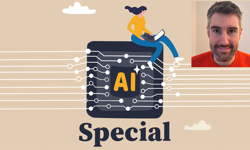
Q: How can AI be used to serve up dynamic registration journeys?
A:
Over the 500 AI experiments we’ve done so far, over 40% were related to building registration and collecting data. There are three areas that we saw the maximum value for dynamic registration:- Analytics and prediction: AI can help process millions of data points across the different channels, CRMs to give a holistic picture of the reader’s media consumption habits. Depending on the recency, frequency and volume of media consumed, AI helps publishers understand the propensity scores and differentiate between casual readers and loyal consumers. AI helps generate insights across content and conversions to help publishers refine both their content strategy and engagement metrics.
- New user experiences: One can use AI and NLP technology to help provide engaging interfaces at optimal times to readers to increase the likelihood of registrations and upsells. Think about providing member-only experiences such as article summaries, ChatGPT like Q&A interfaces.
- Dynamic content locking: Understanding what content is valuable to readers is another area we have seen AI being used. Being able to measure the uniqueness of a content piece can be crucial in taking a decision on whether to put it behind a paywall and AI can enable that.
Q: How can AI be used to increase user engagement?
A:
User engagement is defined differently for different publishers. Even within the same publication, different themes or topics of articles require different type of user engagement. AI can help publishers build and experiment with different strategies at scale for the entire publication. Think about experimenting with:- AI-generated interactive content in different formats like polls, quizzes, summaries, audio etc to deliver additional value to readers
- Personalised content recommendations to readers based on their interests and the content they are reading
- Chatbots and RAG systems that can enhance engagement on homepages and index pages to provide a more personalised experience to readers. These systems leverage the power of generative AI to produce nuanced responses that allow readers to actively engage with the content. They are also a great way of collecting feedback from the readers and understand gaps in the content strategy.
Q: How can AI be used to improve editorial productivity?
A:
Generative AI capabilities can be leveraged by editors as an assistant to not only help in researching the open web for trends and things to write about, but also create drafts that they can build upon and own the narrative. After analysing processes in 50+ media titles, we saw three main areas for building productivity using AI:- Content discovery and drafting. This category includes multiple tasks ranging from identifying trending topics to redaction based on editorial guidelines. You can also convert data into article drafts. Building these kind of “assistants” can save hours of valuable time to focus on producing the best content for your audience.
- Content analytics. This category covers using AI to understand what kind of content is creating more engagement and conversions. Adding a semantic layer around all your data can save hours and weeks of analysis.
- Content distribution. Imagine the hours of time you can save in SEO optimisation if an AI agent could read the content, find the meta tags that give maximum visibility to the content.
To be clear, there is no silver bullet here. AI gives you capabilities to experiment but building productivity is only achieved with experimentation to find areas of value.
Q: What are the pitfalls publishers need to avoid when implementing AI solutions?
A:
There are three areas that publishers need to pay attention to when it comes to implementing AI solutions:- Data management. Ai is only as good as good as the data it processes. Better categorised and organised data will produce better results with AI.
- Skills management. Though ChatGPT has made life easier for all, understanding AI implementation requires a certain amount of expertise. Whether that is an understanding on to how to train AI models or how to decode data stacks.
- Expectations management. AI is not a “code in shiny armour”. If there’s a lack of clear objectives, continuous monitoring and alignment with business goals, AI implementation may lead to ineffective use of resources and disappointment across the different internal stakeholders. AI can help learnings scale at an exponential rate but optimising the tech to produce the desirable results takes time and patience.
Q: For those publishers who haven’t started experimenting with AI, what advice would you give them?
A:
Having worked with multiple publishers who have seen great results with AI, I can confidently say that the opportunity cost for not adopting AI is high. Whether that’s for content, UX, distribution or any other workflow that is critical to business. I also understand the reluctance of different publishers with this tech especially as it still has a lot of rough “arrays”.Hearing concerns of publishers, I am reminded of the Iron Man movies. We clearly observe the evolution of both Iron Man and Jarvis, and how they go on to save the multiverse. The key thing to note is the genius always resided with Tony Stark. AI, aka Jarvis, just made it easier to implement that genius.
I would advise publishers to perceive AI nothing but just that, a tool that enhances capabilities and allow businesses to repurpose their time to serve their community with quality, information and ease. But it also can be the reason why their businesses will shrink, while the competition uses AI to beat them.
Q: How do you anticipate publishers’ usage of AI technology evolving over the next couple of years?
A:
Do we remember Microsoft’s Clippy? I see AI evolving as a version of that where it sits on screens waiting for our next prompt, eager to produce something that satisfies publishers’ everyday needs. Instead of downloading multiple softwares to perform different tasks, a single UI that changes form depending on the task and responds to our queries in natural language. It will evolve to augment human creativity and operational capabilities at a whole new level. We are already seeing many AI taskforces building prototypes such as the “Ask FT” experience or Newsquest’s creation of internal tools to aid editorial productivity. Using AI to build productivity and create better customer experience will see different flavours from different software vendors and internal teams.Q: What’s in the pipeline from Bridged Media?
A:
In the current media landscape, experimentation is key. That is where our focus has been. We have been investing in making the AI models accessible and even allowing publishers to build they own layer of SLMs. With a major roadblock for publishers being long tech sprints in a world where anything that happened two months ago can be coined as “old skool”, speed and efficiency is key.Our solutions have recently been made in a self-service platform, that allows technical and non-technical teams to built products both of productivity and CEX without tech sprints.
We now have a library of 20+ “AI Assistants” publishers can use, mainly under two categories:
- Content Assistants. Productivity tools that help save time for editorial teams. We recently launched a free limited version that any publisher can use as a Chrome Plugin
- Customer Experience (CEX) Assistants. These are AI assistants that create more outcomes on page (email addresses collected, subs, ad impressions, etc). We are building innovative AI experiences.
Feedback from publishers has been the most valuable resources for us and we hope to keep building more practical, productive and ethical AI assistants that benefit them.
Last but not the least, we have been invited by GNI, FIPP and FT Strategies and a few others to help execute on AI programs. This is a big indicator for us on how they value our AI Assistant platform.

About us
Bridged Media offers an AI platform service to publishers and media organisations to accelerate business growth with the help of turnkey AI assistants. Currently, 40+ publishers from across the globe are using these assistants to:
- Simplify newsroom and commercial operations
- Develop data-driven content and personalisation
- Gather insights to drive editorial and revenue strategy










